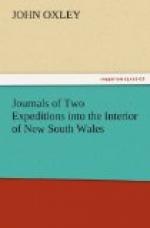September 4.—After leaving the valley in which we encamped, we entered one much more extensive, and communicating with Goulburn Vale. Between five and six miles on our route, we reached a beautiful small river coming from the eastward and joining Peel’s River, of which it appears to be a principal branch. For the remainder of the day’s journey, we proceeded up the fine valley which this stream watered, bounded on the north and south by lofty and fertile hills covered with rich herbage, having numerous smaller valleys and streams terminating in this principal valley. The whole scenery was thinly clothed with wood, and occasionally a bold craggy promontory terminating at the river gave it a diversity, which its general softness of feature or outline required: there were no principal ranges of hills, but they broke in and upon each other, forming the utmost variety of shape. The rocks and stones which composed the bases and summits of these hills, were not less various than their form: scarcely two were alike. Granite, coarse porphyry, freestone, and whinstone were frequently found on the same hill, and the beds of the streams were of every variety of pebble. This fine stream received the name of Cockburn River.
September 5.—Our course this day sometimes led us over very elevated ridges, and at other times through deep and rich valleys. Some of these hills were at least three thousand feet in height, and clothed with grass to their summits. Others of the less elevated were entirely free from rocks, and of the finest soil. The timber chiefly box, with some few trees of another species of eucalyptus called stringy bark, and cypress. A number of small streams watered the deep valleys to the north and south, falling into Cockburn River. Large quantities of quartz were in various places, as also good flint, which was found in large masses in the bed of Cockburn River, and also in small pieces on the hills. This was the second flint that has been discovered in New South Wales. We halted in a small and beautiful valley near Cockburn River, after having accomplished nine miles.
September 6.—A day of rest. The observations place this station in lat. 31. 04. 35 S., long. 151. 05. 30. E., variation 9. 58. E.
September 7.—The morning clear and fine. At half past seven o’clock we proceeded on our journey: in the whole course of it, we never experienced more precipitous travelling than during the first six miles. Travellers, less accustomed to meet difficulties, might perhaps have been a little alarmed at traversing such steep and shelving hills, the loose stones on which added to the insecurity of our footing. Nevertheless we found it extremely pleasant, from the romantic beauty of the scenery and the freshness of the verdure. We had been ascending an extremely elevated country for the last thirty miles; and I was in great hopes of soon reaching the point of division between the eastern and western waters. By a




